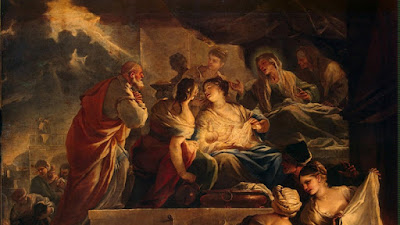On the Second Saturday after Corpus Christi is the Mass in Some Places (pro aliquibus locis) of the Most Pure Heart of Our Lady. Listed in the back of the Angelus Press Missal with other Masses "in some places and congregations" is a short description: "Mary began her journey along the road to perfection at a height to which other Saints arrive only at the end of a long life of saintliness. In all other children of Adam original sin prevented the divine generosity from having a free course. But Mary was created immaculate, and therefore the grace of God streamed into her soul without check or hindrance. Her sinlessness, her heavenly purity, directed every action, every moment to God. Her Heart was the batter and model of all virtues, of her purity. 'Blessed are the pure in heart!'"
INTROIT Ps. 44. 14-15
All the glory of the King's Daughter is within, in golden borders, clothed round about with variety: after her shall virgins be brought to the King, her neighbours shall be brought unto thee. (P.T. Alleluia, alleluia). Ps. My heart hath uttered a good word: I speak of my works to the King. Glory be to the Father . . .
COLLECT
Almighty and everlasting God, who in the Heart of Blessed Mary the Virgin didst prepare a dwelling worthy of the Holy Ghost: mercifully grant, that we who with devout minds celebrate the festival of that most pure Heart, may be enabled to live according to Thine own Heart. Through our Lord.
EPISTLE Canticles, 8. 6-7
Put me as a seal upon thy heart; as a seal upon thine arms; for love is strong as death; jealousy is hard as hell; the lamps thereof are lamps of fire and flames. Many waters cannot quench charity, nor shall the floods drown it; if a man have given all the substance of his house for love, he shall despise it as nothing.
GRADUAL Wisdom 7:25-26
Naught that is defied cometh into her: she is the brightness of eternal light, and the unspotted mirror of God's Majesty; and the image of His goodness. (Cant. 6. 2). I to my beloved, and my beloved to me, who feedeth among the lilies.
Alleluia, alleluia. My soul doth magnify the Lord: and my spirit hath rejoiced in God my Saviour. Alleluia.
GOSPEL Luke 2:48-51
At that time: The Mother of Jesus said to Him: Son, why hast Thou done so to us? behold, Thy father and I have sought Thee sorrowing. And He said to them: How is it that you sought me? Did you not know that I must be about my Father's business? And they understood not the word that He spoke unto them. And He went down with them, and came to Nazareth, and was subject to them. And His Mother kept all these words in her heart.
OFFERTORY Jud 15:11
Because thou hast done manfully, and hast strengthened thy heart: therefore also the hand of the Lord hath strengthened thee, and thou shalt be blessed forever.
SECRET
To Thy majesty, O Lord, we offer up the Lamb without blemish, beseeching Thee that in our hearts may be enkindled that divine fire, which so ineffably consumed the heart of the Blessed Virgin Mary. Through the same Lord.
COMMUNION Canticles. 2. 3
Under the shadow of Him whom I desired have I sat down, and His fruit is sweet to my taste.
POSTCOMMUNION
Refreshed by Thy divine gifts, we humbly entreat Thee, O Lord, that by the intercession of the Blessed Virgin Mary whose most pure Heart we now solemnly celebrate, we may be delivered from present dangers, and obtain the joys of everlasting life. Through our Lord.
















